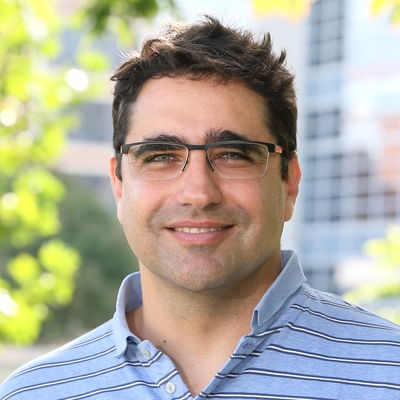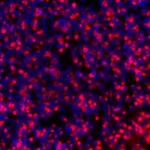
Andres M. Lebensohn, Ph.D.
Stadtman Investigator
Laboratory of Cellular and Molecular Biology
NCI/CCR
Research Topics
Overview:
During embryonic development, secreted cues are received by cells and decoded through cascades of biochemical reactions called cell signaling pathways to faithfully execute many cellular programs, including self-renewal, differentiation, migration and apoptosis. Similar cell-to-cell communication mechanisms are used by stem cells to maintain and regenerate most tissues of adult organisms. Remarkably, only a dozen or so signaling pathways orchestrate the thousands of instructions required to transform a fertilized egg into a human being. This is possible because signaling pathways have evolved additional regulatory mechanisms superimposed on conserved ‘core modules’ that endow them with new biological functions.
The long-term goal of our research is to understand how signaling pathways drive the many different cellular processes that give rise to tissues and organs during embryonic development and maintain them in adult life. We seek to discover new regulatory mechanisms and understand how they modify signaling outcomes in distinct physiological contexts. Since these same signaling pathways can cause devastating diseases when they become dysregulated, understanding their context-specific regulation will also open new therapeutic avenues.
We have begun to address these questions by studying WNT signaling, a fundamental pathway that encodes positional information in animals, orchestrates patterning and morphogenesis during embryonic development, and promotes tissue renewal and regeneration in adults. Dysregulation of WNT signaling has been implicated in many diseases, including many types of cancer. Despite intensive research efforts, there are still no FDA-approved drugs that can selectively treat WNT-driven tumors, which constitute over 90% of all colorectal cancers and a large percentage of many other cancer types.
Our research strategy begins with the identification of new WNT pathway components through powerful genetic screens in cultured haploid human cells (Lebensohn et al., eLife 2016; Patel, Lebensohn et al., PLoS One 2019). We use a combination of CRISPR-based genetic analysis, cell biology and biochemistry to dissect new signaling mechanisms (Lebensohn & Rohatgi, eLife 2018; Dubey et al., eLife 2020, McKenna et al. BioRxiv 2024). We explore these mechanisms in human cells, organoid cultures and animal models to elucidate how regulatory additions to the WNT pathway give rise to distinct physiological outcomes, and how defects in these processes cause disease.
Research Projects:
New regulatory mechanisms in WNT signaling:
Through forward genetics screens in haploid human cells harboring a fluorescent reporter of WNT signaling, we discovered regulators of the intact pathway as well as those selectively required to sustain hyperactive, oncogenic signaling. These studies comprised seven genome-wide screens systematically interrogating the pathway, including screens for positive, negative and attenuating regulators of ligand-induced signaling, as well as suppressor screens following disruption of key regulators commonly mutated in WNT-driven tumors, such as the tumor suppressor APC. A comparative analysis of the screens revealed new regulatory mechanisms for ligand reception, signal transduction and transcriptional activation, as well as new gene regulatory elements. The following research projects are aimed at elucidating some of these new regulatory mechanisms and evaluating their therapeutic potential.
1) The transcription factor TFAP4 is a new limiting component of the WNT signaling pathway.
Our genetic screens uncovered a basic helix-loop-helix leucine zipper transcription factor called TFAP4 as a potential regulator of WNT signaling. We have shown that TFAP4 is a limiting component for WNT signaling activity. Furthermore, excess TFAP4 can promote ectopic activation of WNT signaling during Xenopus laevis development, causing the formation of a secondary body axis. TFAP4 is upregulated in colorectal cancer, where it mediates epithelial-mesenchymal transition (EMT) and metastasis, and its down-regulation in gastric cancer cells inhibits proliferation, induces cell cycle arrest and promotes apoptosis. We are dissecting the molecular mechanism by which TFAP4 regulates WNT signaling, and evaluating its potential as a therapeutic target.
2) A new function of the b-catenin destruction complex regulating WNT signaling through the ubiquitin ligase HUWE1.
HUWE1 is a HECT-domain ubiquitin ligase involved in dozens of cellular processes through the ubiquitination of diverse substrates. HUWE1 has been postulated as a negative regulator of WNT signaling through at least two distinct mechanisms. However, in our unbiased forward genetic screen for mediators of hyperactive WNT signaling induced by loss of the b-catenin destruction complex kinase casein kinase 1a, we identified HUWE1 as a positive regulator of the WNT pathway. We also demonstrated that HUWE1 potentiates WNT signaling in cells and in Xenopus laevis embryos. We have now found that HUWE1 promotes WNT/b-catenin signaling through a mechanism independent of the control of b-catenin protein stability. Potentiation of WNT signaling by HUWE1 requires its ubiquitin ligase activity and a subset of b-catenin destruction complex components. These results reveal a new role for some destruction complex components in mediating WNT signaling through HUWE1, distinct from their established activity in controlling b-catenin stability.
New regulatory mechanisms in R-spondin signaling:
R-spondins are key regulators of WNT signaling strength, but the mechanisms by which they transduce signals are not fully understood and how the four different members of the family control distinct physiological functions is unknown. We discovered that R-spondins 2 and 3 can uniquely potentiate WNT signaling in cells lacking their only known cell-surface receptors, LGRs 4-6, through an alternative interaction with heparan sulfate proteoglycans (HSPGs). LGRs were thought to be required to transduce all R-spondin signals and hence determine their site of action, but now we know that R-spondins can also signal through HSPGs in tissues where LGRs are not expressed. The following research projects are aimed at elucidating the molecular mechanisms and physiological functions of ‘HSPG-dependent’ signaling by R-spondins.
3) Molecular mechanisms of HSPG-dependent signaling by R-spondins.
A central question regarding any signal transduction mechanism is how binding of the ligand to the receptor communicates the signal across the plasma membrane and into the cell. In the prevailing model, simultaneous binding of R-spondins to LGR receptors and to the transmembrane ubiquitin ligases ZNRF3 or RNF43 triggers their internalization. This prevents ZNRF3 and RNF43 from targeting WNT receptors for ubiquitin-mediated degradation, thus increasing their abundance on the cell surface and enhancing sensitivity to WNT ligands. We are investigating the molecular mechanisms whereby R-spondins transduce signals in the absence of LGRs through their alternative HSPG receptors to potentiate WNT signaling.
4) Physiological roles for LGR-dependent and HSPG-dependent signaling by R-spondins during embryonic development and in stem cells.
Gene amplifications followed by neo- or sub-functionalization of different gene family members underlie much of the functional diversification generated during evolution. Yet, paralogues are often deemed to be redundant, and drastically different phenotypes resulting from their loss are simply attributed to tissue-specific patterns of expression. This is the prevailing view regarding the four members of the R-spondin family. However, the markedly distinct phenotypes caused by the loss of different R-spondins or their LGR receptors could also be due to intrinsic differences in the capacity of these R-spondins to signal through LGR-dependent and HSPG-dependent mechanisms. We are investigating in what contexts these two modes of signaling are used during development, tissue homeostasis and regeneration. We are also trying to understand what unique properties make LGR-dependent and HSPG-dependent R-spondin signaling specifically suited to their physiological functions.
Biography
Andres Lebensohn grew up in Buenos Aires, Argentina. He obtained his B.A. in molecular and cell biology from the University of California at Berkeley, where he conducted undergraduate research in enzymology with Dr. Daniel E. Koshland, Jr. He obtained his Ph.D. in cell and developmental biology from Harvard University, where he used biochemical reconstitution approaches to study regulation of the actin cytoskeleton by the WAVE complex in the laboratory of Dr. Marc W. Kirschner. He then pursued postdoctoral studies as a Helen Hay Whitney Foundation fellow in the laboratory of Dr. Rajat Rohatgi at Stanford University. In close collaboration with Dr. Jan Carette, he conducted reporter-based, forward genetic screens in haploid human cells to uncover new regulatory mechanisms in WNT signaling. Dr. Lebensohn joined the Laboratory of Cellular and Molecular Biology in October of 2018. He lives in Bethesda with his wife Alexandra (who is a cancer genetic counselor at NIH) and their two children, Gabi and Ani (who snuck into some photos in the Lab Life section of the website). When not in the lab, you may find him fishing and crabbing in the Chesapeake Bay, paddleboarding in the Potomac River and biking the Capital Crescent Trail.
Related Scientific Focus Areas




Molecular Biology and Biochemistry
View additional Principal Investigators in Molecular Biology and Biochemistry

This page was last updated on Tuesday, April 29, 2025